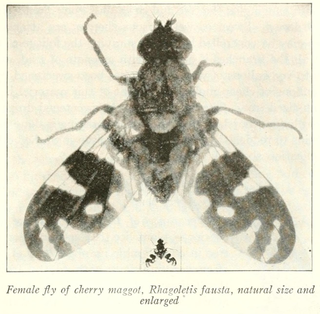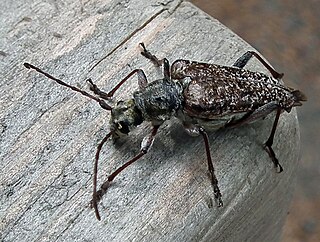
Entomology is the scientific study of insects, a branch of zoology. In the past the term insect was less specific, and historically the definition of entomology would also include the study of animals in other arthropod groups, such as arachnids, myriapods, and crustaceans. This wider meaning may still be encountered in informal use.

The Asian long-horned beetle, also known as the starry sky, sky beetle, or ALB, is native to the Korean Peninsula, northern and southern China, and disputably in northern Japan. This species has now been accidentally introduced into the eastern United States, where it was first discovered in 1996, as well as Canada, and several countries in Europe, including Austria, France, Germany, Italy and UK.

The longhorn beetles (Cerambycidae), also known as long-horned or longicorns, are a large family of beetles, with over 35,000 species described.

Parcoblatta virginica, the Virginia wood cockroach, is a small cockroach species of the genus Parcoblatta, measuring about a centimeter long as an adult.

Parcoblatta fulvescens, the fulvous wood cockroach, is a species of cockroach endemic to the United States and possibly Canada that measures around 13 mm (0.5 in) long.
Francis Polkinghorne Pascoe was an English entomologist mainly interested in beetles.

Augustus Radcliffe Grote was a British entomologist who described over 1,000 species of butterflies and moths. He is best known for his work on North American Noctuidae. A number of species were named after him, including the moth Horama grotei.
The Entomological Society of Canada or Société d’Entomologie du Canada is one of Canada's most historic scientific societies. The society was founded in Toronto on April 16, 1863. The first Council was composed of President Henry Holmes Croft (1820–1883), Secretary Treasurer William Saunders (1836–1914), and Curator Rev. J. Hubbert. First called the Entomological Society of Ontario, which still exists as the provincial entomological society, it was initially based in London, Ontario before moving in 1906 to Guelph, Ontario. In 1950 the society adopted its present name and moved to Ottawa.

Clusiidae or "druid flies" is a family of small, thin, yellow to black acalyptrate flies with a characteristic antenna and with the wing usually partially infuscated. They have a cylindrical body. The head is round, the vertical plate reaches the anterior margin of the frons and the vibrissae on the head are large. The costa is interrupted near subcosta and the latter developed throughout length. Larvae are found in the bark of trees, the flies on trunks. The larvae are notable for their ability to jump. Males of many species in the subfamily Clusiodinae have been observed while engaged in lekking behaviour. There are hundreds of species in 14 genera found in all the Ecoregions, although most species occur in tropical regions. The type genus is Clusia Haliday, 1838.

Edmund Murton Walker was a Canadian entomologist. He described the genus Grylloblatta in 1914 which he then considered as a member of the Orthoptera and later placed it in a separate order Grylloblattodea but which are now included in the order Notoptera.

Rhagoletis fausta, the black-bodied cherry fruit fly, is a species of tephritid or fruit flies in the genus Rhagoletis of the family Tephritidae. It is found in the United States and Canada.
Spinules are small spines or thorns that are part of biological and manmade structures. The word originates from the Latin word spinula and is often used in botany and zoology.
Charles Howard Curran was a Canadian entomologist who specialized in Diptera. Curran's main taxonomic interests were in brachyceran flies, particularly the flower flies Syrphidae, in which he described 723 species. He described 2,648 species over his career. He was active in the study of insect control. His 1934 work The Families and Genera of North American Diptera was an important and comprehensive work on the topic of North American fly genera.

Anthophylax attenuatus is the species of the Lepturinae subfamily in long-horned beetle family. This beetle is distributed in Canada, and USA. Adult beetle feeds on sugar maple, American beech, and on hophornbeam.

Neoptychodes trilineatus is a species of flat-faced longhorn beetles in the subfamily Lamiinae.

Lepturobosca chrysocoma is a species of beetle in the family Cerambycidae. It was described as Cosmosalia chrysocoma by William Kirby in 1837. In 1998, comparison of Cosmalia chrysocoma with Lepturobosca virens by the Russian entomologist Alexander Ivanovich Miroshnikov resulted in Cosmalia and Lepturobosca grouped together under the name Lepturobosca. Common names used for this beetle include Yellow velvet beetle, Golden flower longhorn beetle and Golden-haired flower longhorn.
Eugene Gordon Munroe was a Canadian entomologist who discovered numerous species of insects. He worked for the Insect Systematics and Biological Control Unit, Entomology Division in Ottawa, Ontario, Canada.

Trichoferus campestris, the velvet longhorned beetle, is a species of long-horned beetle in the family Cerambycidae.

John Alston Moffat was a British-born Canadian entomologist who served as librarian and secretary to the Entomological Society of Ontario for fourteen years.

Charles Frederic August Schaeffer was an American entomologist who specialized in beetles, particularly chrysomelids and weevils. He described 109 species in 91 genera and some species like Taphrocerus schaefferiNicolay & Weiss were described from his collections and named after him.














